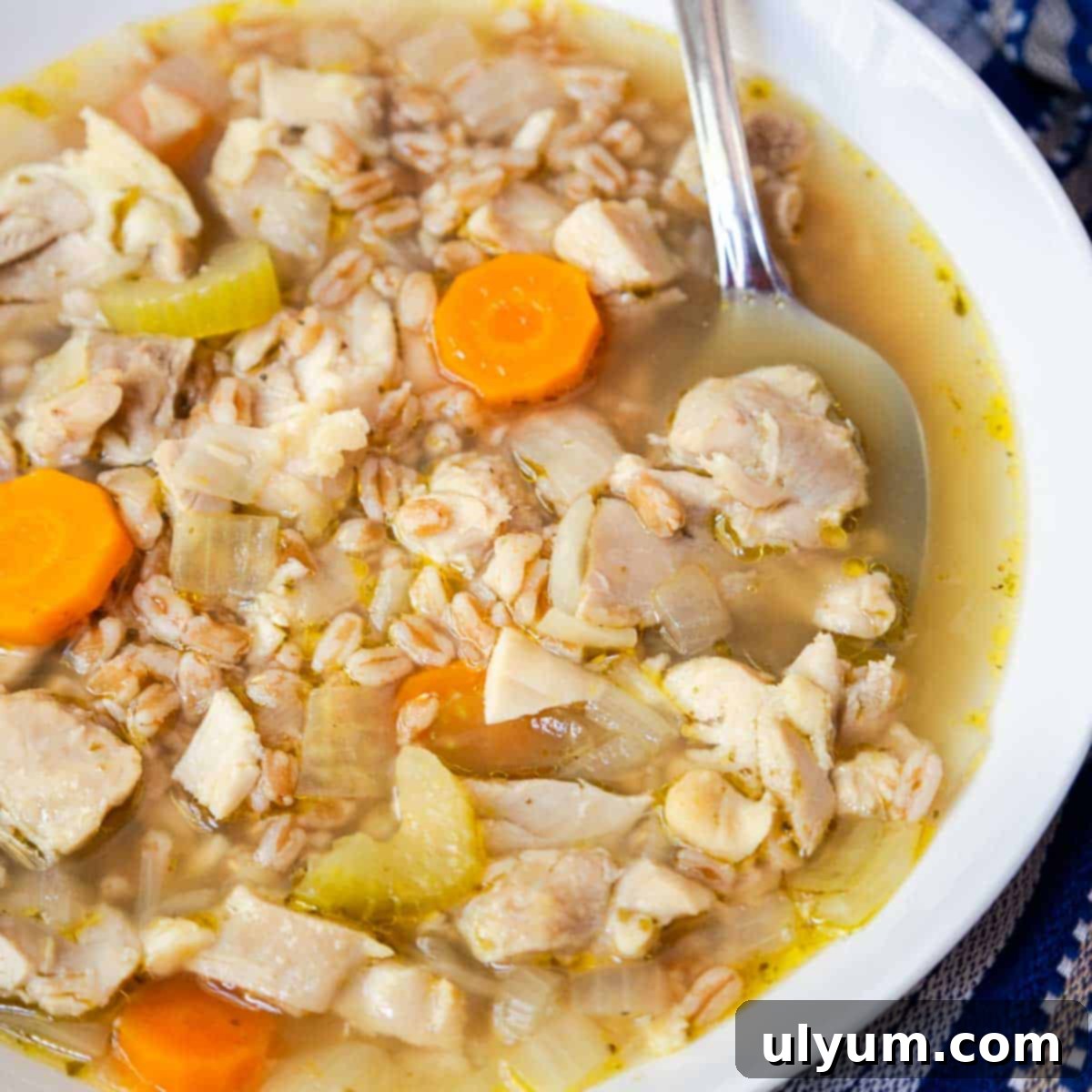Hearty & Healthy Chicken Farro Soup: A Delicious One-Pot Comfort Meal
This chicken soup with farro is a delightful twist on a timeless classic, offering a comforting and nutritious meal perfect for any day. Crafted with tender chicken thighs, rich chicken stock, sweet carrots, and the distinctive chewiness of farro, enhanced by aromatic Italian seasoning, this recipe elevates your soup experience. It’s an incredibly satisfying dish that brings warmth and flavor to your table with minimal effort.
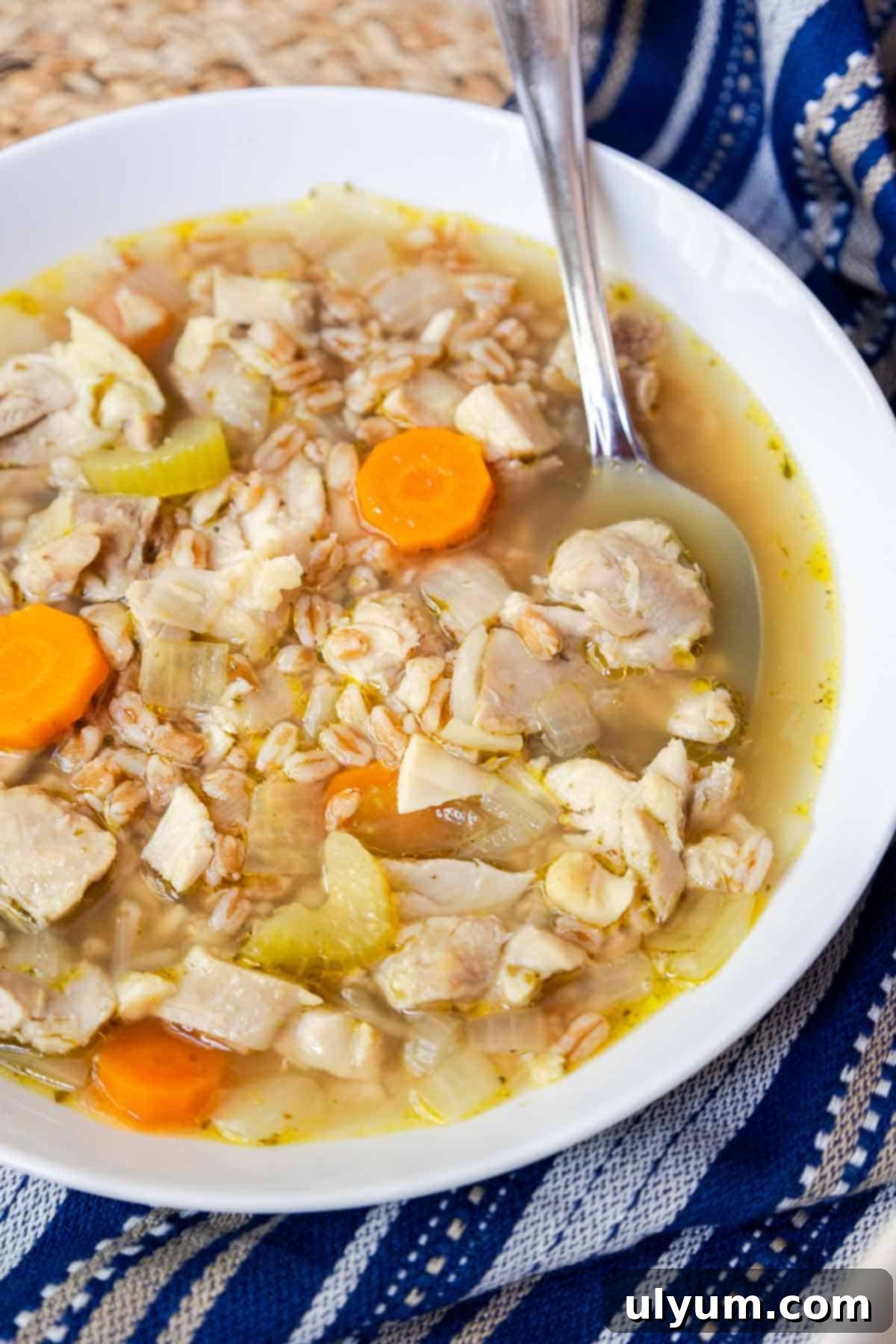
This post contains affiliate links. As an Amazon Associate, I earn from qualifying purchases.
When the weather turns chilly, or you simply desire a deeply nourishing and wholesome dinner, this chicken farro soup stands out as the perfect choice. It’s generously packed with succulent, diced chicken, the distinctively nutty and chewy ancient grain farro, and a vibrant medley of garden vegetables. This harmonious blend transforms a classic into a modern favorite, providing a more substantial and intriguing texture than traditional chicken noodle soup. Get ready for this farro soup to become a staple on your weeknight dinner rotation, offering both comfort and a unique culinary experience.
If you’re looking for more comforting and hearty soup recipes to warm you up during the cooler months, be sure to explore my delightful creamy mushroom and lentil soup, a rich and earthy option, and my flavorful slow cooker buffalo chicken chili, perfect for a spicy kick. These recipes are sure to enhance your soup season with diverse and satisfying flavors.
Recipe Highlights: Why You’ll Love This Chicken Farro Soup
- Nutrient-Rich Farro: This ancient grain is the star of this soup, providing a wonderfully chewy, hearty texture and a subtle, earthy flavor that beautifully complements the chicken and vegetables. Unlike pasta or white rice, farro is exceptionally high in fiber, offering significantly more dietary fiber than both white and even brown rice. This not only makes the soup more satisfying and filling but also contributes to digestive health and sustained energy. Incorporating farro is an easy way to boost the nutritional value of your meal without sacrificing taste or comfort. Look for semi-pearled or pearled farro for optimal cooking time and texture in soups.
- Comforting and Highly Versatile: At its core, this is a deeply comforting dish, built upon a clear, savory broth base and featuring tender, boneless chicken thighs. Its simplicity is its strength, allowing you to easily customize it to your personal preferences. Feel free to experiment with additions like sweet corn for a pop of color and sweetness, a swirl of cream for a richer texture, a squeeze of fresh lemon juice for brightness, or a sprinkle of fresh herbs like parsley or dill. This soup serves as a fantastic canvas for your culinary creativity, ensuring every bowl is exactly how you like it.
- Effortless One-Pot Preparation: Say goodbye to piles of dirty dishes! This recipe is a true “one-pot wonder,” designed for maximum flavor with minimal cleanup. The genius lies in cooking the raw chicken and the farro directly in the same pot with the vegetables and broth. This not only saves time but also allows the chicken to infuse the broth with its rich flavors as it cooks, resulting in a more deeply savory soup. From start to finish, you’ll appreciate the simplicity and convenience of this easy, wholesome meal, making it perfect for busy weeknights.
[feast_advanced_jump_to]
Essential Ingredients for Your Chicken Farro Soup
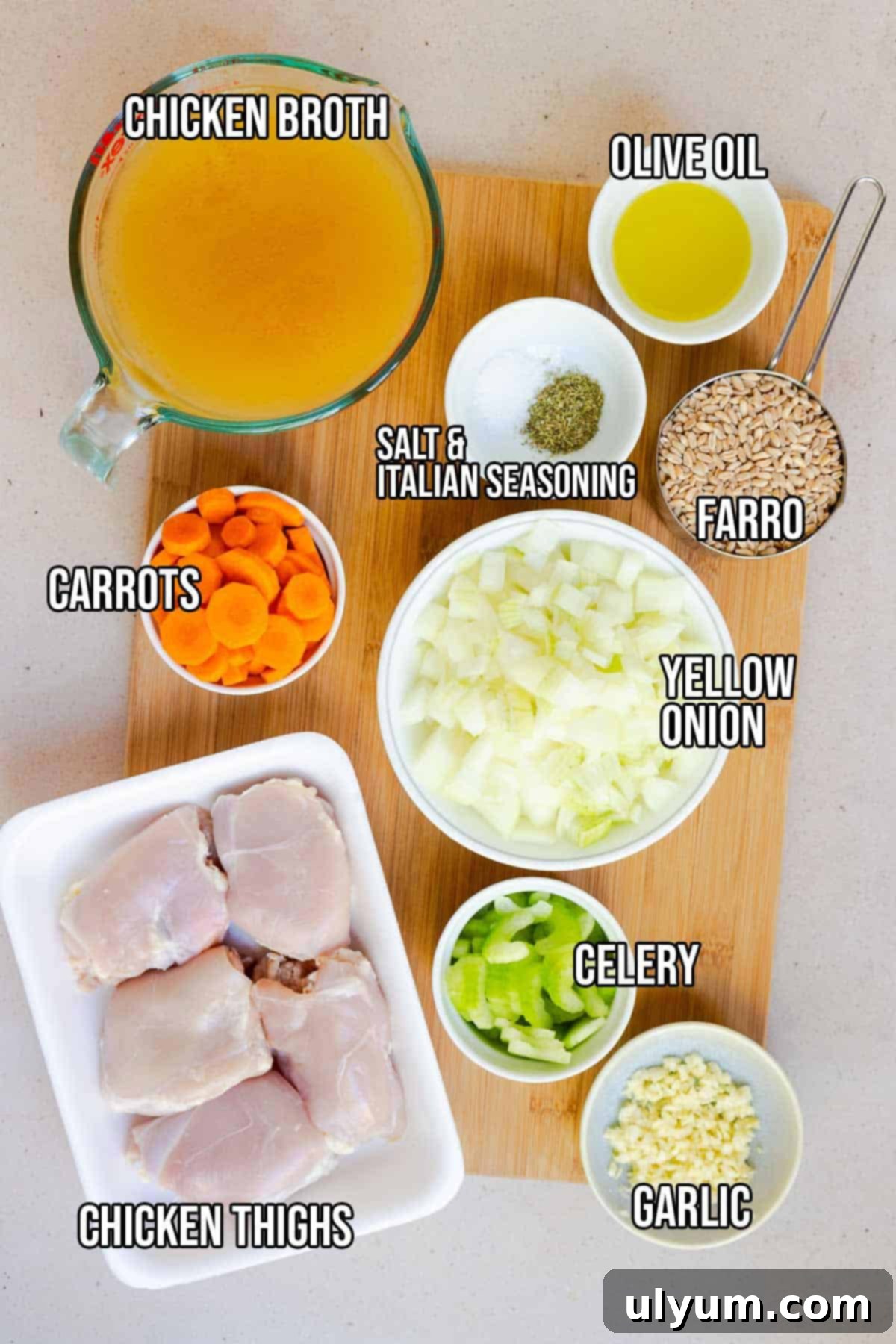
Gathering fresh, high-quality ingredients is the first step to creating a truly delicious and comforting chicken farro soup. Here’s a detailed look at what you’ll need to make this wholesome meal:
- Olive Oil: Two tablespoons of good quality olive oil provide the perfect base for sautéing your vegetables, helping to soften them and release their natural sweetness and aromatic compounds into the pot.
- Yellow Onion: One large yellow onion, finely diced, forms the critical aromatic foundation. As it sautés, it sweetens and deepens the overall flavor profile of the soup.
- Carrots: Two medium carrots, peeled and either sliced or diced, add a natural sweetness, vibrant color, and essential nutrients to the soup. They become wonderfully tender after simmering.
- Celery: One celery stalk, sliced, completes the classic mirepoix (onion, carrot, celery) combination. It contributes a subtle earthy and slightly bitter note that perfectly balances the sweetness of the other vegetables.
- Garlic: Four cloves of fresh garlic, minced, are indispensable for imparting a pungent and incredibly fragrant aroma to the soup. Add it towards the end of sautéing to ensure it doesn’t burn.
- Chicken Broth: Six cups of chicken broth (or chicken stock) form the savory liquid base of this soup. Opt for a low-sodium variety to give you better control over the final seasoning of your dish. Chicken stock, made from bones, will offer an even richer depth of flavor.
- Italian Seasoning: Half a teaspoon of Italian seasoning, a robust blend typically featuring dried basil, oregano, thyme, rosemary, and marjoram, infuses the soup with classic, warming Mediterranean-inspired flavors.
- Salt: Half a teaspoon of salt, or more to taste, is crucial for enhancing and balancing all the flavors. Remember to adjust at the end; it’s easier to add more than to remove it.
- Boneless Skinless Chicken Thighs: One pound (about 4) boneless, skinless chicken thighs are the star protein. Dark meat is ideal for this soup because it stays exceptionally tender and juicy during the simmering process, cooking through at a similar pace to the farro. This prevents the chicken from drying out, which can happen with leaner cuts.
- Farro: One cup of uncooked farro, an ancient grain with a distinctive nutty flavor and a satisfyingly chewy texture, adds substance and a rustic appeal. It’s also packed with fiber. You can typically find farro in the grains aisle, alongside other whole grains like rice and quinoa.
Refer to the recipe card below for exact quantities and precise measurements.
Step-by-Step Instructions for Making Chicken Farro Soup
Creating this delicious and hearty chicken farro soup is a straightforward process, even for beginner cooks. Follow these simple steps to bring a warm and flavorful meal to your table in under an hour.
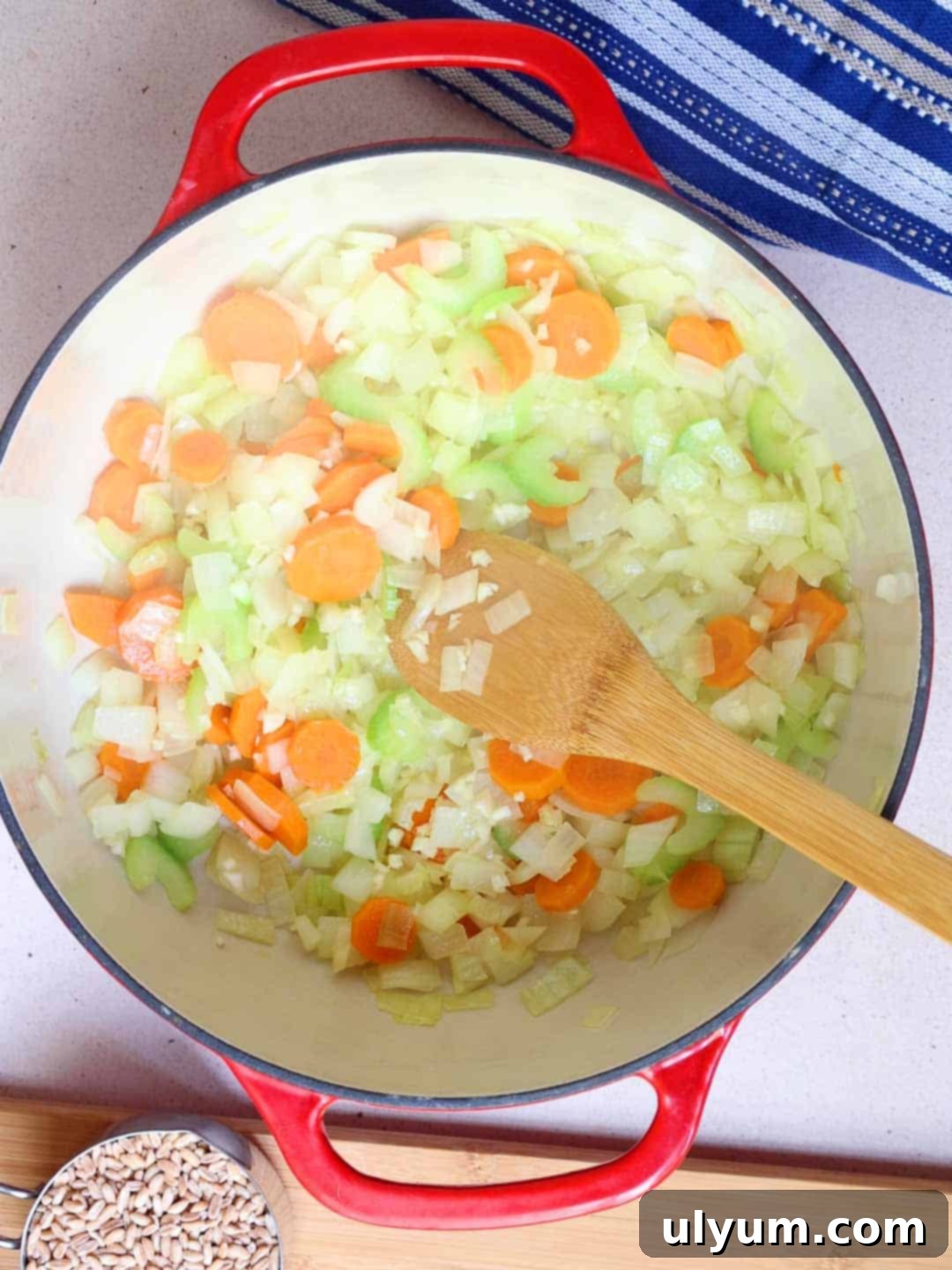
Step 1: Sauté the Aromatics
Begin by heating the olive oil in a large, heavy-bottomed pot or Dutch oven over medium heat. Once shimmering, add the diced yellow onion, sliced carrots, and sliced celery. Sauté these vegetables, stirring occasionally, for approximately 5 minutes, or until the onion becomes translucent and softened. This initial step builds a flavorful foundation for your soup, allowing the vegetables to release their sweetness. Next, add the minced garlic to the pot and continue to sauté for just 1-2 minutes more, until it becomes wonderfully fragrant. Be careful not to burn the garlic, as it can quickly turn bitter.

Step 2: Add Liquids and Seasoning
Pour in the chicken broth, then stir in the Italian seasoning and an initial amount of salt. Remember, you can always add more salt later to taste, so start conservatively. Increase the heat to medium-high and bring the soup mixture to a rolling boil. This ensures all the flavors begin to meld and prepares the pot for the upcoming addition of chicken and farro, allowing them to cook efficiently in the hot liquid.
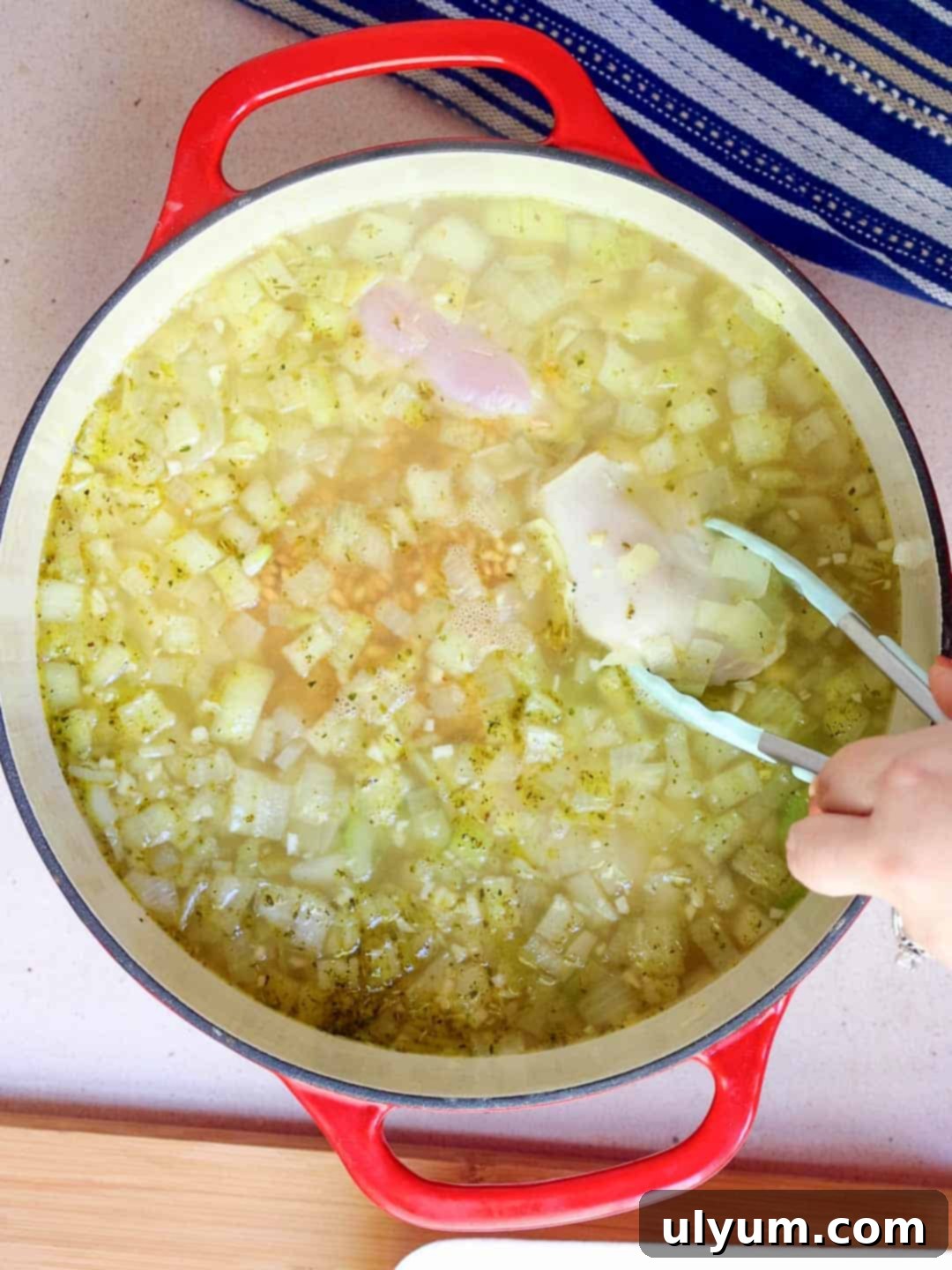
Step 3: Simmer Chicken and Farro
Carefully add the boneless, skinless chicken thighs (whole) and the uncooked farro to the boiling broth, ensuring they are fully submerged in the liquid. Once everything is in, reduce the heat to low, cover the pot, and let it simmer gently for approximately 20-25 minutes. Stir occasionally to prevent the farro from sticking to the bottom of the pot. Cook until the chicken thighs reach an internal temperature of 165°F (73.9°C) and the farro is tender yet still has a pleasant chew. Pro Tip: If your chicken cooks faster than the farro, don’t hesitate to remove the chicken from the pot early to prevent it from overcooking and becoming dry. You can set it aside on a cutting board while the farro finishes its cooking time, then shred it before returning it to the soup.
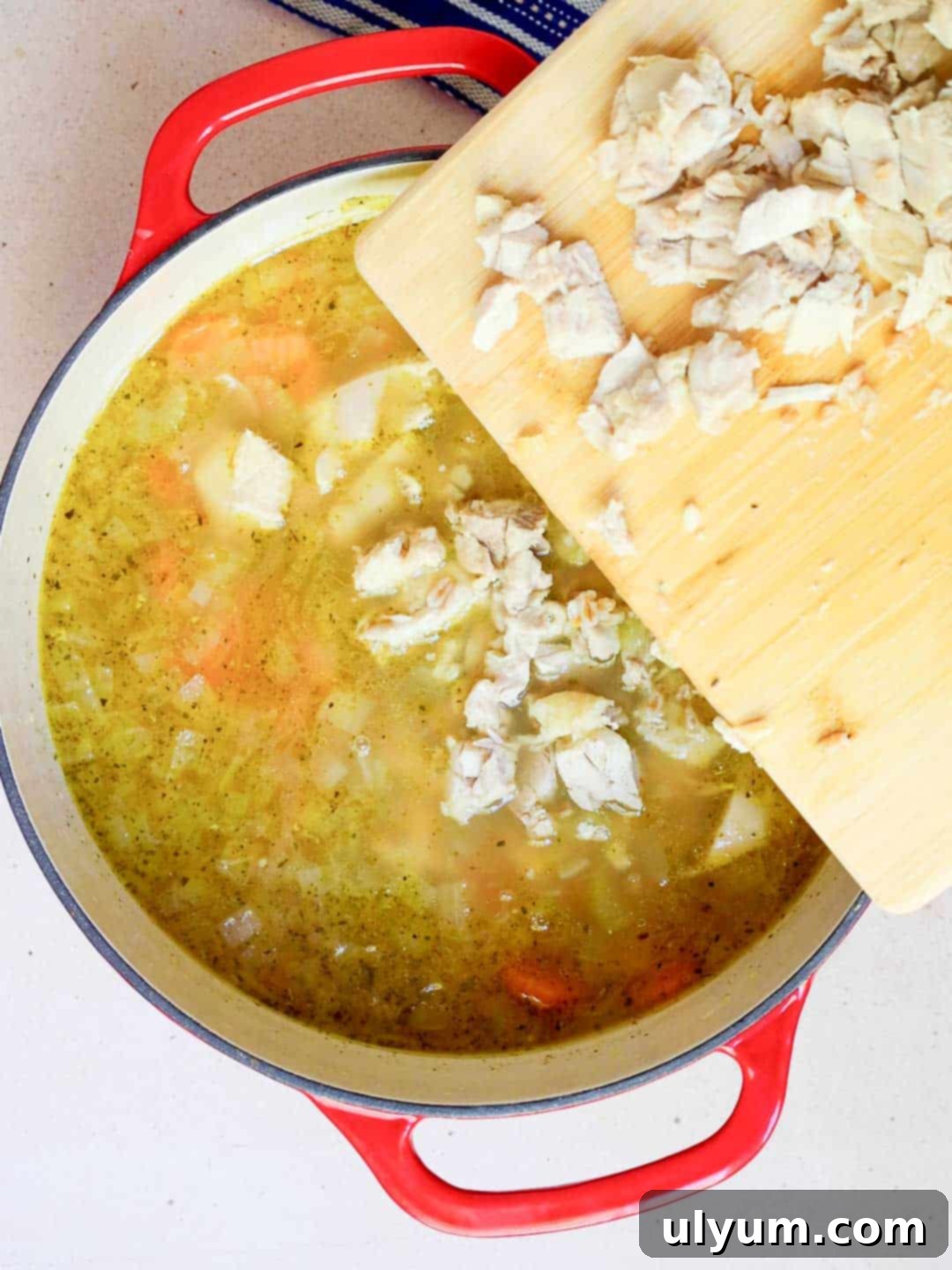
Step 4: Shred and Serve
Once the chicken thighs are fully cooked and the farro is tender, remove the chicken from the pot (if you hadn’t already). Using two forks, shred the chicken into bite-sized pieces, or dice it into uniform cubes if you prefer a neater presentation. Return the shredded or diced chicken back into the soup pot, stirring gently to combine it with the farro and vegetables. Give the soup a final taste and adjust the seasoning as needed; this is your chance to add more salt, a pinch of black pepper, or extra Italian seasoning to perfectly suit your palate. Serve hot and enjoy your homemade, comforting chicken farro soup!
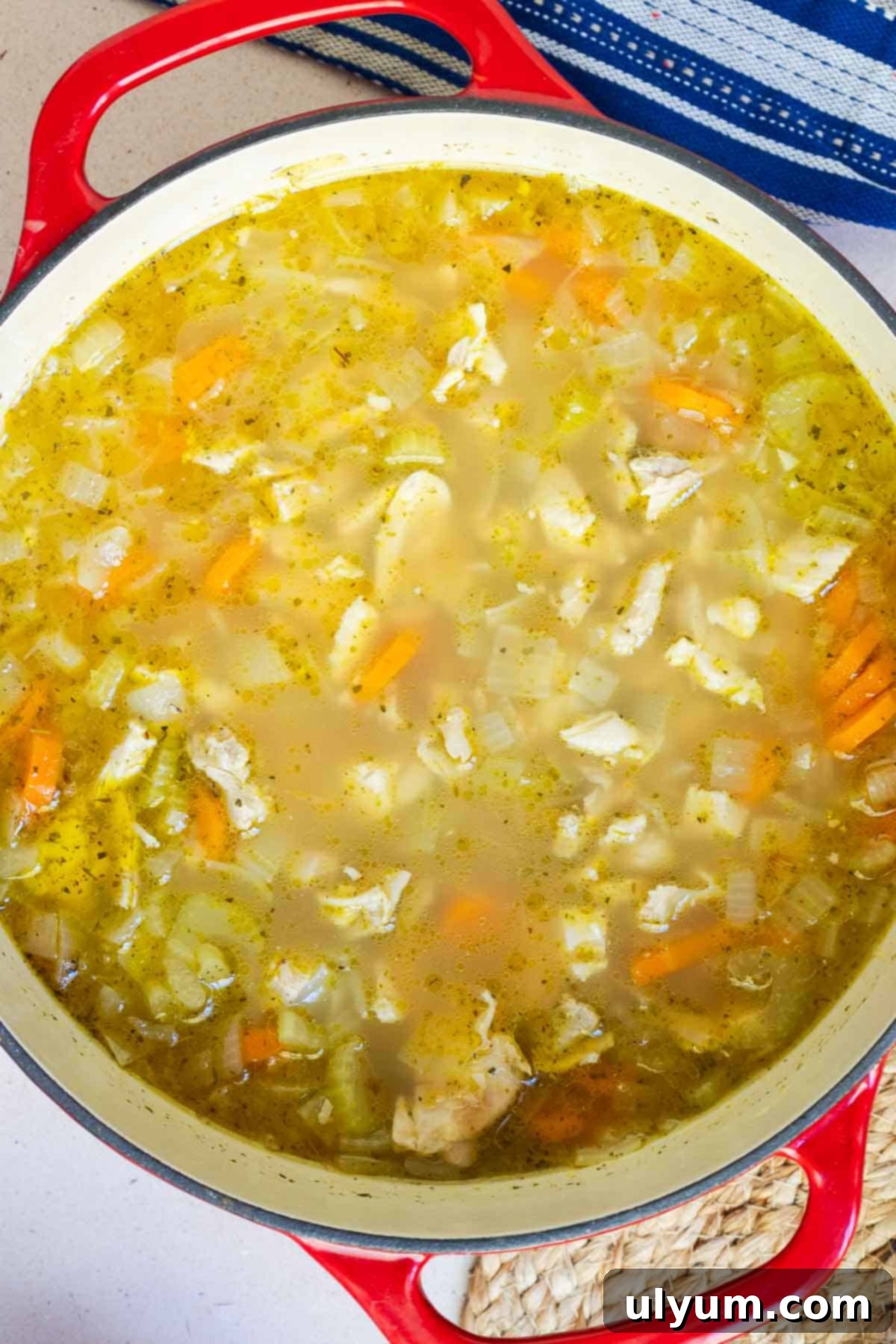
Smart Substitutions for Your Farro Chicken Soup
While this recipe is perfect as written, don’t hesitate to make adjustments based on what you have on hand or your dietary preferences. Here are some smart substitutions that work well, ensuring you can still enjoy a delicious and comforting meal:
- Yellow Onion: I typically prefer yellow or white onions for soups due to their balanced flavor profile. However, if you’re looking for a slightly milder and sweeter alternative, shallots can be an excellent substitute, offering a more delicate onion flavor. In a pinch, you can also use onion powder, though fresh onion provides superior texture and depth, especially as part of the mirepoix base.
- Chicken Broth: The quality of your broth significantly impacts the soup’s overall flavor. Chicken stock, which is often richer due to being made with bones and a longer simmering process, is a fantastic substitute for chicken broth. For a vegetarian option, or if you prefer a different flavor profile, vegetable broth works well. If you only have water, you can combine it with bouillon cubes or a concentrated chicken base to create a flavorful liquid, adjusting the amount to taste.
- Italian Seasoning: If you don’t have a pre-made Italian seasoning blend, you can easily create your own with individual dried herbs. A good rule of thumb is to combine equal parts of dried oregano, basil, and thyme, with a smaller pinch of dried rosemary and marjoram. This allows you to tailor the herbal notes to your liking, ensuring the soup has that classic aromatic touch. Fresh herbs, added at the end, can also provide a burst of flavor.
- Chicken Thighs: While boneless, skinless chicken thighs are highly recommended for this soup because they stay incredibly moist and tender during simmering, you can certainly use chicken breasts. However, chicken breasts are leaner and can become dry if overcooked. To prevent this, closely monitor their internal temperature (165°F or 74°C) and remove them once they reach doneness, even if the farro still needs more time. Alternatively, if you have pre-cooked chicken (like leftover rotisserie chicken), simply shred or dice it and add it to the pot during the last few minutes of simmering, just long enough to heat through.
Creative Variations to Enhance Your Soup Experience
This chicken farro soup is incredibly versatile, lending itself well to a variety of creative twists. Don’t be afraid to experiment and make it your own based on your preferences or what ingredients you have on hand!
- Chicken and Rice Soup: For a more traditional grain, simply replace the farro with long-grain white rice or a heartier brown rice. This will give the soup a different, more familiar texture and flavor profile, creating a truly classic comfort food. Consider adding some fresh parsley or a squeeze of lemon at the end to brighten the flavors.
- Creamy Chicken and Wild Rice Soup: Elevate the richness of your soup by incorporating dairy. After the soup has simmered and the grains are tender, stir in a splash of whole milk, half-and-half, or heavy cream for a velvety, indulgent texture. This variation pairs beautifully with wild rice, offering an earthy, wholesome, and incredibly satisfying creamy soup.
- Chicken and Brown Rice Soup: For a quicker, yet still wholesome option, especially if you’re short on time, utilize pre-cooked rotisserie chicken and pre-cooked brown rice. Add the cooked chicken (shredded or diced) and brown rice towards the end of the simmering process, just enough to warm them through and allow them to absorb the delicious broth flavors. This significantly cuts down on overall cooking time.
- Spicy Chicken Farro Soup: If you enjoy a bit of heat, add a pinch of red pepper flakes or a dash of your favorite hot sauce along with the Italian seasoning. You can also incorporate diced jalapeños or a spoonful of chili paste for a more intense spice level.
- Mediterranean Farro Soup: Introduce a bright and zesty twist by stirring in fresh lemon juice and plenty of chopped fresh dill or parsley at the end of cooking. A handful of fresh baby spinach or chopped kale can also be wilted directly into the hot soup for added greens and nutrients.
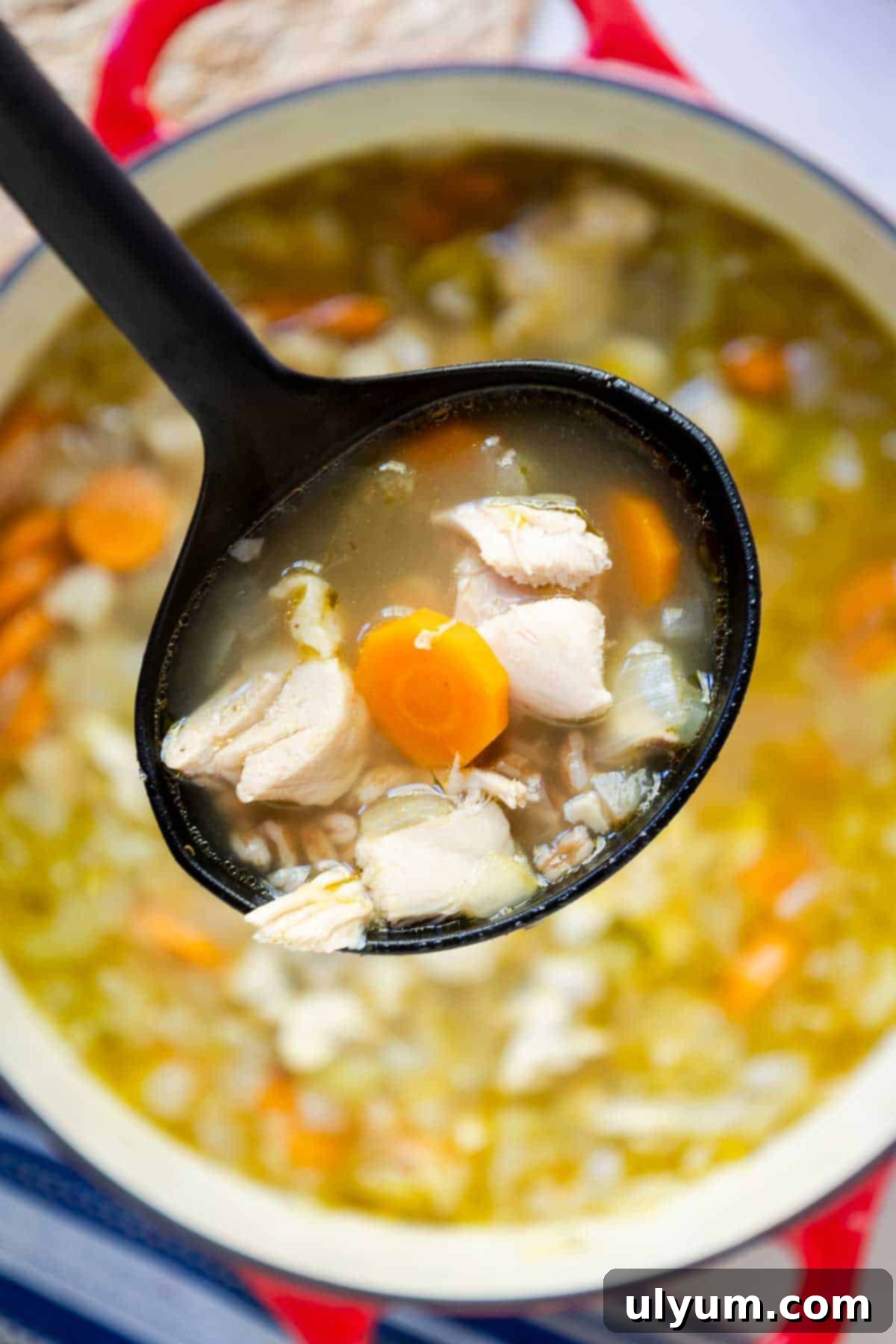
Essential Equipment for Your Soup Success
Having the right tools can make your cooking experience smoother and more enjoyable. Here’s what you’ll need to prepare this delicious and hearty chicken farro soup efficiently:
- Large Pot: A spacious 6-quart pot or a sturdy Dutch oven is absolutely essential for this one-pot recipe. It needs to be large enough to comfortably hold all your ingredients (chicken, farro, vegetables, and broth) and allow for proper simmering without overflowing. A heavy-bottomed pot, like the Lodge 6 Quart Enameled Cast Iron Dutch Oven, is excellent for even heat distribution, which helps prevent sticking and ensures consistent cooking.
- Tongs: These are incredibly useful for safely adding raw chicken thighs to the hot liquid and then removing them once they are cooked through. Tongs provide a firm grip, minimize direct contact with hot liquids, and keep your hands safely away from steam.
- Cutting Board and Chef’s Knife: These are fundamental tools for all your chopping and slicing needs, from dicing the onion and slicing carrots and celery at the start to shredding the cooked chicken at the end. A sharp, well-maintained chef’s knife makes prep work safer and significantly more efficient.
- Meat Thermometer: This is your absolute best friend for ensuring perfectly cooked chicken. It allows you to accurately check the internal temperature of the chicken thighs, preventing both undercooked meat (which is unsafe) and overcooked meat (which becomes dry and tough).
Storage and Reheating Tips for Leftover Soup
This chicken farro soup makes excellent leftovers, often tasting even better the next day as the flavors deepen and meld. Proper storage ensures its freshness, quality, and safety for future enjoyment.
Fridge: To store any leftover soup, first allow it to cool completely to room temperature. This is a crucial food safety step, ideally completed within 2 hours of cooking. Once cooled, transfer the soup to a clean, airtight container. When stored in the refrigerator, the soup will remain fresh and delicious for up to 4 days. You might notice that the farro absorbs more liquid over time, making the soup slightly thicker than when first prepared. However, it will maintain its pleasant chewy texture, preventing it from becoming mushy, which is a common concern with some other grains.
Freezer: For longer storage, this chicken farro soup freezes beautifully, making it an excellent option for meal prepping or having a quick, wholesome meal on hand. Once the soup has entirely cooled down, portion it into freezer-safe containers or heavy-duty freezer bags. If using bags, lay them flat in the freezer to optimize space and allow for quicker, more even thawing. The soup can be safely stored in the freezer for up to 3 months. When freezing liquids, remember to leave a little headspace in containers to account for expansion.
Reheating: When reheating refrigerated soup, you have a couple of convenient options. You can gently warm it in a pot over medium-low heat on the stovetop, stirring occasionally, until it reaches your desired temperature and is piping hot throughout. Alternatively, for individual portions, cover and microwave for one to two minutes, stirring halfway through, until thoroughly heated. For frozen soup, it’s best to thaw it overnight in the refrigerator first. Once thawed, reheat using the same methods as for refrigerated soup. If the consistency has become too thick after sitting or freezing, simply add a splash of extra chicken broth or water to thin it out to your preference.
Top Tips for Perfect Chicken Farro Soup Every Time
Achieving a perfectly cooked chicken farro soup is easy with these expert tips, ensuring a delicious and satisfying meal every time:
To avoid the common pitfall of overcooked or undercooked chicken, always use a reliable meat thermometer. Insert the probe into the thickest part of the chicken thigh, being careful to avoid any bones, which can give an inaccurate reading. The safe internal temperature for cooked chicken is 165°F (73.9°C). If your chicken reaches this temperature before the farro is tender, simply remove the chicken from the pot and set it aside on a clean cutting board. This prevents the chicken from becoming dry and tough while the farro finishes cooking to its ideal chewy texture. Once the farro is ready, shred or dice the chicken and return it to the pot.
Another valuable tip for delicious farro: While simmering, remember to stir the soup occasionally, especially as the farro cooks. This prevents the grains from sticking to the bottom of the pot, helps them cook evenly, and ensures they remain separate and chewy rather than clumpy. If, during the simmering process, the soup appears to be getting too thick or the liquid is reducing too quickly before the farro is fully tender, don’t hesitate to add an extra splash (½ to 1 cup) of chicken broth or water to maintain the desired consistency. This ensures your soup remains perfectly brothy and flavorful.
Frequently Asked Questions About Chicken Farro Soup
Yes, absolutely! You can substitute boneless, skinless chicken breasts for chicken thighs if that’s what you prefer or have on hand. However, it’s important to keep in mind that chicken breasts are much leaner and may cook faster than thighs. This means they can become dry and tough if overcooked. To prevent this, it’s crucial to closely monitor their internal temperature. Remove the chicken breasts from the pot as soon as they reach 165°F (74°C), even if the farro still needs a few more minutes to cook. You can then shred or dice them and return them to the soup once the farro is done, ensuring they remain tender.
Yes, this soup is an excellent candidate for making ahead! In fact, many people find that the flavors of the chicken, vegetables, and farro meld even more beautifully overnight, resulting in a richer, more cohesive taste the next day. Simply follow the recipe instructions, allow the soup to cool completely to room temperature, and then store it in an airtight container in the refrigerator. When ready to serve, gently reheat on the stovetop over low heat or in the microwave. You might want to add a little extra broth or water when reheating, as the farro tends to absorb more liquid as it sits, making the soup thicker.
For this chicken farro soup recipe, semi-pearled or pearled farro is generally recommended. These varieties have some or all of their outer bran layer removed, which allows them to cook faster and more consistently in soup, resulting in a tender yet chewy texture. Whole farro can be used for its maximum nutritional benefits, but it will require a significantly longer cooking time (up to an hour) and may benefit from being soaked overnight beforehand to reduce cooking duration. Always check the package instructions, as cooking times can vary slightly between brands and types of farro.
To make your chicken farro soup even heartier, you can easily add more vegetables! Consider incorporating diced potatoes, sweet potatoes, green beans, peas, or corn during the last 10-15 minutes of simmering. A can of drained and rinsed cannellini beans or chickpeas can also add extra protein and fiber. For a richer flavor, you might swirl in a tablespoon of pesto or a sprinkle of grated Parmesan cheese just before serving.
More Comforting One-Pot Meals You’ll Love
Looking for more easy and satisfying one-pot recipes to simplify your meal prep and minimize cleanup? Here are some other favorites that deliver big on flavor with minimal fuss:
- One Pan Lemon Chicken Orzo
- One Pan Salmon Pesto Pasta
- One Pan Coconut Lime Chicken
- One Pan Creamy Garlic Pork Chops
Did you make this recipe? I’d love to hear what you think! Please take a moment to leave a rating and review—it helps me create high-quality recipes and lets others know what to expect. Your feedback is truly valuable!
📖 Recipe
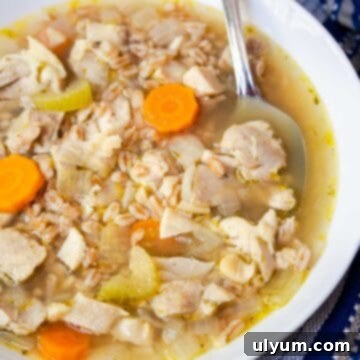
Pin Recipe
Save RecipeSaved!
Email
Print
Easy Chicken Soup with Farro
Equipment
-
Large pot
-
Tongs
-
Cutting board
-
Chef’s knife
-
Meat thermometer
Ingredients
- 2 tablespoons olive oil
- 1 large yellow onion diced
- 2 medium carrots peeled and sliced
- 1 celery stalk sliced
- 4 cloves garlic minced
- 6 cups chicken broth
- ½ teaspoon Italian seasoning
- ½ teaspoon salt or to taste
- 1 pound boneless skinless chicken thighs about 4 thighs*
- 1 cup farro uncooked
Instructions
-
In a large pot, heat the olive oil over medium heat. Add the diced onion and sliced carrots and celery, cooking until the onion is translucent, about 5 minutes. Add the minced garlic and sauté 1-2 minutes more or until fragrant.
-
Add the chicken broth, Italian seasoning, and salt (to taste). Increase the heat to medium-high to bring the soup to a boil.
-
Add the chicken thighs (whole) and farro, submerging in the liquid. Reduce the head to low, cover, and simmer for about 20-25 minutes, stirring occasionally until the chicken thighs are cooked through (165°F or 73.9°C) and the farro is tender.
-
Remove the cooked chicken thighs and shred with two forks or dice into bite-sized cubes. Return to pot. Taste and adjust the seasoning as needed.
Video
Notes
Storage: To store leftover soup, ensure it cools completely to room temperature within two hours. Then, transfer it to an airtight container and refrigerate for up to 4 days. The farro will absorb more liquid over time, but it will maintain its chewy texture, preventing it from becoming mushy.
Freezer: This soup is freezer-friendly! Once entirely cooled, portion it into freezer-safe containers or heavy-duty freezer bags. For bags, lay them flat in the freezer to optimize space. The soup can be stored in the freezer for up to 3 months. Thaw overnight in the refrigerator before reheating.
Nutrition
Important Food Safety Guidelines
Ensuring food safety is paramount when preparing any meal, especially those involving raw chicken. Following these guidelines will help keep your kitchen and your food safe from harmful bacteria and cross-contamination:
- Wash Hands and Utensils Thoroughly: Always begin and end your cooking process by washing your hands thoroughly with soap and warm water for at least 20 seconds, especially before and after handling raw chicken. Make sure to meticulously clean any utensils, cutting boards, or surfaces that come into contact with raw chicken using hot, soapy water. Dedicated cutting boards for raw meat (e.g., color-coded) can be a helpful practice to prevent cross-contamination.
- Cool Soup Promptly Before Storing: To inhibit harmful bacterial growth, it’s crucial to cool your soup to room temperature as quickly as possible, ideally within 2 hours of cooking. Never place a large, hot pot of soup directly into the refrigerator, as it can raise the internal temperature of the appliance and compromise the safety of other foods. Instead, divide large batches into smaller, shallow containers, or place the pot in an ice bath to rapidly cool it before refrigeration or freezing.
- Store in Airtight Containers: When storing your chicken farro soup, always use clean, food-grade airtight containers. These containers are essential for maintaining the soup’s freshness, preventing it from absorbing unwanted odors from other foods in the fridge, and most importantly, guarding against potential bacterial contamination. Ensure the lids are securely fastened to avoid any spills and to preserve the delicious flavors and quality of your homemade soup. Labeling containers with the date of preparation is also a good practice.
For more comprehensive information and detailed guidelines on safe food handling and preparation, please consult the reliable resources available at USDA.gov, which provides up-to-date recommendations for food safety in your home kitchen.
